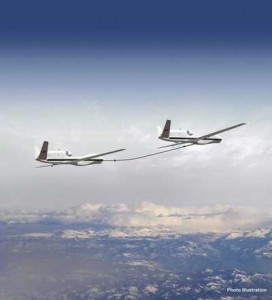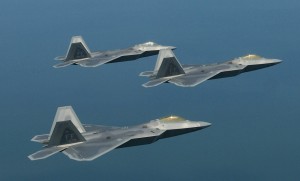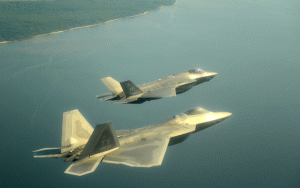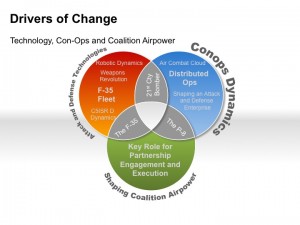2013-11-14 by Lt. General (Retired) Deptula
Since the early days of aviation the progress and the accomplishments of air and space power have been legendary. Airpower changed the face of warfare—not just in terms of precision and lethality, but in all its facets from logistics, to intelligence, to mobility, mission support, and survivability.
However, today it’s becoming evident that we’re moving into a future very different from the past.
As a result, we need to chart a path to future fighter force structure much differently in the 21st century—the “information age”—than we did in the 20th century—the industrial age of warfare.
Today, airpower allows us to project asymmetric, effective power with surprise and initiative while minimizing vulnerability. It’s time to exploit these advantages to an even greater degree than we have in the past.
Rather than simply modernizing the means of executing traditional military responses, we need to capitalize on airpower to yield new solutions.
However, that will require not just education as to the effects of airpower, but also a seat at the table so the political decision-makers understand the options airpower provides.
It’s interesting to note that Operations Northern and Southern Watch—the no-fly zones over Iraq from 1991 to 2003 lasted 12 years. They demonstrated that airpower could exert a credible, immediate threat of precise force application, or impose a high or low visibility monitoring regime, without significant risk to personnel, the high cost, or number of resources or people involved in achieving similar effects through a traditional occupation of territory on the ground.
Compare the effectiveness of 12 years of the air exclusion zones that contained Saddam Hussein’s aggressiveness, to the nearly decade long application of ground forces in Iraq and over 12 years in Afghanistan. In over 12 years of no-fly zone operations over 391,000 sorties were flown with zero losses—let me say that again…12 years; 391,000 sorties; zero losses—and at a fraction of the cost of ground operations with their associated loss of thousands of lives, resources, and trillions of dollars.
Given the real-world evidence of the alternatives of air-centric verses ground-centric operations, aerospace options should gain growing attention to political leadership as we move forward.
However, there’s a huge lack of political understanding and public awareness of airpower.

Airpower historian John Olsen has amplified that situation in stating that, “we have a really good case, but we’ve been bad at presenting it for the past 100 years…” We have to do better.
That said, better integration of all military forces, was—and still is—an objective of jointness.
We can take jointness one step further by integrating diplomacy, information, and economics with military elements to achieve vastly improved unity of effort to meet our security challenges. Applied with strategic skill, these multi-dimensional levers of power—when acting in concert—can deliver decisive effects at particular points in time, often at less cost in blood, treasure and prestige, than can military action alone.
It does little good to perfect military capabilities and concepts of operations in isolation from the other elements of power and influence.
In other words, a concept of operations cannot compensate for a lack of strategy.
One of the topics we discussed was the evolution of unmanned aircraft and the future of air warfare. Over the past 10 years these aircraft have achieved a maturity and contribution of great significance.
However, we have really just witnessed the initial steps of unmanned aircraft—their promise is boundless as we move into the future.
It’s important to realize that the unmanned aerial vehicles (UAV)—or perhaps more accurately termed today—remotely piloted aircraft (RPA), are but just one element of what can be a complex, geographically distributed, and resource-intensive set of operations.
UAVs represent the pointy end of what in some cases is a very long spear.

So I think it’s important to recognize the entire network of links, architectures, and analysts that comprise the entire system associated with the use and exploitation of unmanned aircraft.
It’s the total package that’s required to deliver the value of the remotely piloted aircraft themselves.
Because these aircraft make use of networks that allow us to retain the bulk of our footprint outside of harm’s way we are ever more able to project power without projecting vulnerability—that provides an asymmetric advantage that adversaries find difficult to counter.
The steadily increasing capacity of these systems to deliver desired security effects is one of the two most significant reasons we’re seeing an explosion in demand for remotely piloted aircraft. The second development has been the changing character of some of the threats we face. During the Cold War finding our adversaries was easy—finishing them was more challenging. Today the situation is reversed—finishing adversaries is easy…finding them is the challenge, and that places a premium on the importance of conducting effective intelligence, surveillance, and reconnaissance or ISR.
ISR today is the linchpin of our ability to conduct traditional find-fix-finish operations, and it’s increasingly being performed by fighter aircraft as an integral part of their traditional missions.
All that said, behind the hardware, the concepts, the engineering, design, and vision that are required to create remotely piloted aircraft are people. Their imagination, innovation, dedication, and support have brought, and continue to bring to fruition the promise of remotely piloted aircraft.
So with people so critical to this enterprise, referring to it as an “unmanned system” is paradoxical at best, and dangerously misleading to the degree that these important tools may be banned by those who don’t want to see a world controlled by autonomous robots.
The future of remotely piloted aircraft is very promising.
However, using remotely piloted aircraft as another means to exploit the advantages of operating in the third dimension of air is becoming a complex issue.
While introducing enormous capability and employment advantages, remotely piloted aircraft are not a panacea for warfare, nor will they replace manned fighters. They are but one tool among many in the set of modern aerospace weapon systems. They have advantages and they have disadvantages.
One of our biggest challenges we also discussed is how very costly it is to build aerospace systems. This is due to a great degree because we are lashed to outdated requirement and acquisition practices with layers and layers of bureaucracy and regulations. It’s time to change the processes that have stifled what used to be a very productive relationship between technology and the warfighters. In the 1940s, 50s, and 60s, aerospace was invigorated by technology with a speed between concept and capability that we can only dream about today where the norm is 20 year long major aircraft acquisition cycles.
What’s possible from a technology standpoint today is inhibited by a set of overly complex acquisition, and operational test and evaluation processes. It’s time to rid us of the mountains of acquisition rules and regulations, and move to collapse the excessive timelines between technological promise, and program reality.
![In this photo, the 8 planes involved in the training are shown. All the plane captains [crew chiefs] are seen standing by their jets. The pilots are in the cockpits. The jets are running. Credit Photo: by Lt Col Gillette, F-35B IP and executive officer at the VMFAT-501](https://sldinfo.com/wp-content/uploads/2013/04/8_Ship_Post_Flight-300x168.jpg)
Doing that will not be easy, but may be aided by empowering fewer decision-makers, reducing layers of oversight, instituting fewer milestones, relying on judgment and accountability to a greater degree than thousands of pages of acquisition regulations—that no one individual can ever comprehend—and by capitalizing on modern technology itself by appropriately relying to a greater degree on modeling and simulation.
Governments may also be well served by capitalizing on what industry has to offer. In many cases the reduction in the size of military staffs has led to a shift in where military innovation lies—from military staffs to the defense industry. The military should embrace and exploit change by better partnering with the innovation and streamlined practices that exist in industry. We all need to learn better how to rapidly adapt new technology to the innovative concepts of operation that technology enables, regardless of where the ideas come from.
Air Commodore Teakle addressed conceptual changes in the use of air and space power and provided us some great insight into the future by addressing new concepts for command and control of aerospace power; how it power can provide a degree of asymmetric dominance; and how it can be an agent of transformation as the centerpiece of new approaches to meeting our security needs.
Underlying these precepts is the fact that we’re not going to meet the budget challenges of the future by simply buying less of what we already have—we need to embrace and invest in innovation, creativity, and change. We need to create a culture and environment that encourages disruptive thinking instead of discouraging it.
We need to realize and exploit the advantages of modern aerospace and information age technology to build new cost-effective concepts of operation.
However, one of our challenges is that people still tend to view cost in terms of individual unit cost, as opposed to cost per desired effect…that better reflects real value—and that is where we need to move the discussion and decision space.
We need to think beyond the constraints that traditional culture imposes on new technology.

For example, 5th generation aircraft such as the F-22 and F-35 are termed “fighters,” but technologically, they are not just “fighters”—they are F-, A-, B-, E-, EA-, RC, AWACS-35s. They are flying “sensor-strikers” that will allow us to conduct information age warfare inside contested battlespace whenever we desire—if we fully exploit their “non-traditional” capabilities to the degree that those capabilities become accepted as the new “traditional.”
To fully capitalize on these capabilities will require a new way of designing our force.
We need to also realize that innovation can be applied to organization as well as from technology. We have to think outside of the organizational constructs that history has etched into our collective psyche. Network-centric, interdependent, and functionally integrated operations are the keys to future military success.
The future needs an agile operational framework for the integrated employment of allied military power.

It means taking the next step in shifting away from a structure of segregated land, air or sea warfare that has come to be know as combined arms warfare, to integrated operations based on the four functions of ISR, strike, maneuver, and sustainment to achieve desired effects—or combined effects warfare.
We’re at a critical juncture in history—at the center of an Information in War Revolution—one where the speed of information, advance of technology, and designs of organizations are merging to change the way we operate. This change has dramatically shortened decision and reaction times, and reduced the number of systems it takes to achieve desired effects.
However, we can fail to realize the full potential of airpower, based on how we look at it. Just as we label the F-35 with a traditional naming convention as a fighter—even though it is much more than that—we tend to view remotely piloted aircraft in terms of how well they can observe and destroy targets. This is a combined arms perspective.
Airpower provides us much more than simply combined arms platforms.
To fully exploit its versatility, we need to pay more attention to combined effects. This paradigm shift will not come easy, as thousands of years of history has inculcated us with a combined arms approach. But we know that precise targeting does not always give us precise effects. So we have to anticipate second, and third, and higher orders of effect in the employment of every aspect of airpower.
For example, look at the observer effect that remotely piloted aircraft have extended to modern warfare. The simple act of observation has caused strategic disruption of terrorist adversaries. When we observe an enemy—and they are aware of the precision effects that can be immediately employed when seen—we dramatically change their behavior.
So, if we focus on combined effects warfare—the end of strategy, rather than force-on-force—the traditional means to achieve it, what we have become accustomed to calling combined arms warfare—we can consider more effective ways to accomplish the same goal more quickly than in the past, with fewer resources, and most importantly, with fewer casualties. Airpower allows us to do that. It can be intertwined with, and contribute to all elements of power—diplomatic, informational, military, economic and social.
But it requires a broader perspective than traditionally applied to airpower in the past—beyond a supporting arm in the combined arms equation.
We need to seek being able to integrate aerospace forces with each of these elements in an interdependent manner.
We need to link aerospace and information-age capabilities with sea and land-based means to create an omni-present defense complex that is self-forming, and if attacked, self-healing. This kind of a complex would be so difficult to disrupt that it would possess a conventional deterrent effect that would be stabilizing to whatever region it is deployed. Through robust, secure, jam/intrusion-proof connectivity, fewer aircraft can achieve higher levels of effectiveness across a larger area of influence than was possible with older, legacy aircraft.
A system of systems approach can integrate complementary weapon systems with carefully tailored capabilities that are responsive to the demands of an Anti-access/Area Denial environment.
This approach is about enabling disaggregated, distributed operations over a fluid operational area. It’s about combining digital tools with effective distributed decision-making.
It’s more akin to a honeycomb than a network, and operations in, from, and through all domains in an integrated fashion will be at the heart of this complex.
The central idea is cross-domain synergy.
The complementary vice merely additive employment of capabilities in different domains such that each enhances the effectiveness, and compensates for the vulnerabilities, of the others. This combined effects approach is about integrating existing and future aerospace capabilities within an agile operational framework guided by human understanding. This ISR/strike complex—or combat cloud—is not just about “things.” It’s an intellectual construct with technological infrastructure.
In the face of disruptive innovation and cultural change, air forces can maintain the status quo, or we can embrace and exploit change. I suggest that the latter is the preferred way to go in the future.
This conference gave us the chance to discuss the potential of fighter aircraft contribution to 21st Century warfare. The discussion and agenda was rich in content and ideas. I’d like to leave you with some final thoughts about the future of fighter aviation for you to ponder and consider over the next year.
In my mind—based upon the points raised in this conference over the past several days—airpower in general, and fighters specifically; can greatly contribute to meeting the challenges of a more complex security environment in the face of declining resources. Why?
Because airpower can shape, deter, and dissuade so we can attain fundamental security interests minimizing the need for combat operations. When combat is necessary, airpower capabilities yield a variety of strategic, operational, and tactical effects that provide disproportionate advantages relative to any other medium of warfare.

Strategies of the past were built to put as many ground forces as possible into harms’ way as quickly as possible. Modern airpower power gives us the potential to change this approach.
Over the last decade of the 20th century and the first decade of the 21st century, Airmen have created a structure of capabilities that have become ubiquitous…as a result; airpower has become the indispensible force.
Fundamentally, it’s up to Airman to articulate what airpower brings to security, because you are the ones who best understand its capabilities and potential. As I mentioned earlier, we need to articulate those capabilities in a way that politicians can understand.
Air, and space power are based on the characteristics of technology—but the invention, design, development, fielding and application of those instruments flow from human imagination, knowledge, and capabilities. Airmen have harnessed technological capabilities to the ever-evolving requirements of security by deterring potential adversaries; and flying, fighting, and winning when necessary. Airmen seize on the virtues of air and space to project power without projecting vulnerability, and as a result, we can provide political leadership with strategic alternatives not available any other way. And that is why air and space power will be in great demand in the future.
That said, there is an aerospace “critical mass,” below which we dare not go lest we risk the loss of the critical capabilities and options that Aerospace provides.
In the United States, what has been labeled “sequestration” will clearly have a long-term impact on that critical mass—not just on the US Air Force, but on all elements of the US military. As a result, the US military will need to have serious discussions about capability verses capacity, and modernization verses force structure recapitalization.
One of the outcomes of this debate will be a question in our partners’ minds about the US ability to maintain commitments and strong relationships. One of the second order effects of the capability verses capacity discussion will be that the United States Air Force will be looking toward our friends for capacity to maintain that Airpower “critical mass.”
This will require stronger, more integrated military-to-military relationships among friends to a degree perhaps much greater than ever before.
In fact, multi-nationality may be the only way to meet our fighter force requirements.
In closing, I am impressed by the innovative thought that was displayed here these past several days, and the perspective of the community of Airmen from all the countries represented here today. I look forward to a continued partnership among our community of nations as we seek better means to secure peace and stability in an ever-changing and complex security environment.
And hearing what we discussed this conference, I’m confident that Airman, and airpower will lead the way.
Editor’s Note: These were the remarks of Lt Gen David A. Deptula, USAF (Ret.) made as Chairman for the Defense IQ 13th Annual International Fighter Conference.
On the impact of coalition as an integral factor to re-shaping 21st century airpower see the following:
https://sldinfo.com/special-report-on-italy-and-the-f-35/
https://sldinfo.com/reset-rebuild-rethink-us-defense-concepts-of-operations/
https://sldinfo.com/the-f-35-the-impact-of-a-global-fleet/
https://sldinfo.com/the-libyan-operation-comparing-the-french-and-usmc-experiences/
For earlier treatments of the honeycomb concept see the following:
https://sldinfo.com/isr-services-to-the-honeycomb/
https://sldinfo.com/the-new-face-of-long-range-strike-in-the-21st-century/
https://sldinfo.com/the-coming-of-the-hypersonic-cruise-missile-a-key-element-of-s-cubed-evolution/
https://sldinfo.com/the-air-sea-battle-concept-and-pacific-operations/
https://sldinfo.com/new-capabilities-new-constraints-call-for-new-concepts-of-operation/
https://sldinfo.com/the-role-of-the-f-35-in-the-future-of-power-projection/
https://sldinfo.com/shaping-redundant-response-u-s-military-space-capabilities/
https://sldinfo.com/the-emergence-of-the-z-axis-changing-the-way-airpower-enables-combat-operations/
https://sldinfo.com/fifth-generation-aircraft-and-3-dimensional-warfare/


